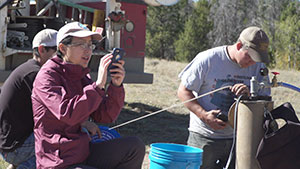UWs Zhang Receives $1M Grant to Study How Forests Naturally Recover After Disturbances
Published October 10, 2022

A University of Wyoming professor has received a U.S. Department of Energy (DOE) grant to study how forests in the Rocky Mountains of North America recover naturally -- with the help of wetlands -- after disturbances such as drought, insect outbreaks and wildfires.
Ye Zhang, in UW’s Department of Geology and Geophysics, recently received a $1 million DOE grant for her project titled “Groundwater-supported vegetation refugia as a mechanism of forest recovery in a Rocky Mountain watershed impacted by wildfire.” The grant, announced Sept. 29 by DOE’s Office of Biological and Environmental Research, began Sept. 21 and runs through Aug. 31, 2025.
Andrew Parsekian, a UW associate professor of geology and geophysics, and Brent Ewers, a professor and head of the UW Department of Botany, will serve as co-principal investigators and collaborate with Zhang on the project with Xiaonan Tai, an assistant professor of biological sciences and an ecohydrology modeling expert at the New Jersey Institute of Technology.
Research results will help inform effective post-disturbance land and forest management practices and strategies in the Medicine Bow National Forest in southeastern Wyoming as well as help other impacted forests in the Rocky Mountain region.
“If we find the reasons why some wetlands have been or are currently active for helping forests regenerate after one or more disturbances, then these wetlands will need to be monitored, protected and potentially enhanced,” Zhang explains. “In this way, we can hope to maximize the efficiency of forest management practices by targeted conservation.”
When two disturbances occur one after another -- such as bark beetles, followed by wildfire -- natural regeneration growth is not guaranteed. For example, the 2020 Mullen fire that raged for more than a month in the Medicine Bow National Forest burned over trees that had been dead for more than a decade after a bark beetle epidemic. As a result, tree regeneration was found to be patchy: Some burnt areas are regenerating quickly, while other areas are not.
“In the Medicine Bow National Forest, we found that healthy and mature trees that survived the fire are now providing seeds to repopulate the impacted areas,” Zhang says of their unfunded fieldwork after the Mullen fire. “However, the trees driving forest regeneration are not found everywhere, but rather are focused in areas of the forest nicknamed ‘forest refugia.’”
An important forest refugia in Medicine Bow National Forest, and in the Rocky Mountains in general, are mountain wetlands with shallow water tables and high soil moisture. By examining the age of the trees, Zhang and her co-principal investigators found that these wetlands have sheltered trees, which provide a seed source against much earlier disturbances. As a result, this helps forests recover after each incident, she says.
“Many of these wetlands are not adjacent to streams or lakes but, instead, are supplied by groundwater, which is water flowing through soil and bedrock in the subsurface, often along the topographic gradient,” Zhang says. “Because groundwater is hidden from view, we know very little about how it supports wetlands and then, the adjacent, upland vegetation.”
With this DOE grant, Zhang says the aim is to map the locations of the wetlands in Medicine Bow National Forest that actively support post-fire forest regeneration.
“By monitoring both groundwater and vegetation processes at these wetland refugia sites, we also aim to understand how, and under what conditions, groundwater drives forest recovery,” Zhang says. “Moreover, facing projected droughts in the near future, some mountain wetlands that are currently forest refugia may become drier, which could diminish their roles for helping the forest. Other wetlands that are currently too wet to support trees may become suitable for hosting seedlings, thus forming new refugia in the future.”
Zhang says the grant is anticipated to support three UW Ph.D. students in the UW Hydrologic Science Program from the Geology and Geophysics and Botany departments as well as a number of undergraduate field and laboratory assistants. Additionally, the grant will support a Ph.D. student to work with Tai.
“Though we cannot exactly predict the future, we will use field measurements collected in this study to calibrate an ecohydrological model to replicate current hydrology and vegetation conditions at the Medicine Bow National Forest refugia sites that we will map,” Zhang says. “Then, we will drive this model using a range of projected climate scenarios for the region to test the above ideas.”
Results of the research could be used by forest managers, the U.S. Forest Service, the U.S. Geological Survey and conservation organizations, she says.

